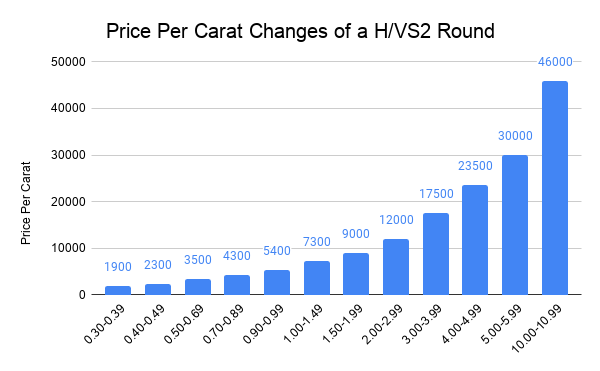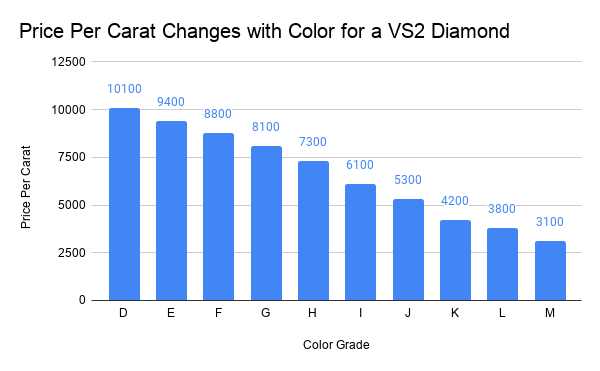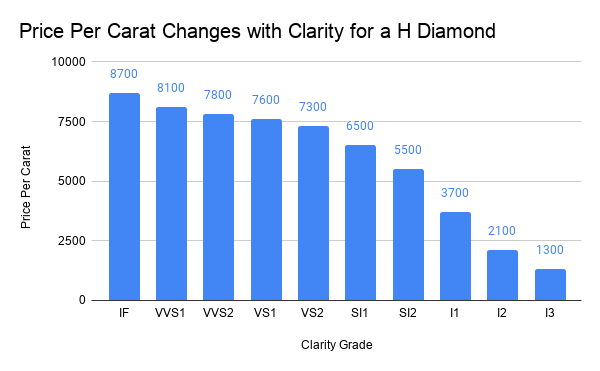Price Per Carat and the 4C's:
If you want to buy a diamond for a good deal, your first instinct is to look at the price tag. But would you know if you got a good price? A small difference in color, clarity or even carat weight could impact the price significantly.
One value will be your best friend: Price per carat. Take the total amount and divide it by the carat weight and boom you have the magic value.
A diamond's value is based mainly on the 4Cs: cut, color, clarity and carat weight but other factors do come into play. Diamond dealers use both price per carat and the 4Cs to determine the final price of the diamond. By using this guide, you can start thinking like a diamond dealer and quickly narrow down your dream stone. Let me help you to navigate all the nitty-gritty of diamond pricing.
The Rappaport - The Inside Scoop:
I would be remiss not to give you the inside scoop about how prices are determined in the diamond industry. Could you believe that almost all diamond prices are determined and negotiated around two red sheets of paper? Sounds crazy right?
Let me introduce you to the legendary Rapaport Diamond Report. Since 1978, the Rapaport Diamond Report has provided the diamond industry with two sheets full of tables of diamond prices (one for rounds and one for pear shapes *stand-in for all fancy shapes). Nowadays, Rapaport has evolved into a full trade magazine and an online marketplace, but the status of the two red sheets has remained significant.
If you want to go the extra mile you could subscribe to their magazine at $180 per month or you could just rely on the AI predicted deal score on Rare Carat do all that calculating for you.
Carat Weight: A Numbers Game
One of the most influential factors is the carat weight and the weight bracket in which the diamond falls under. Generally diamonds are grouped into the following weight ranges: 0.30-0.39, 0.40-0.49, 0.50-0.69, 0.70-0.89, 0.90-0.99, 1.00-1.49, 1.50-1.99, 2.00-2.99, 3.00-3.99, 4.00-4.99, 5.00-5.99 and 10.00-10.99. You can see from the chart that the prices increase exponentially. Everytime the diamond goes up in a weight bracket the per-carat price increases significantly. This characteristic creates interesting phenomena of the critical weight.
For example: let's say we have two almost identical round H/VS2 diamonds. One weighs 0.99ct and the other 1.00ct. Despite being the same in almost every respect, that tiny 0.01ct would create a whopping difference of around $2000. They would be priced around $5346 and $7300 respectively. The critical weight of 1.00ct is responsible for the price difference.
Keep this in mind before you purchase your dream stone. Avoid stones that are on the edge of critical weights such as 1.00ct, because any damage to the stone will likely drop the stone into the less valuable 0.90-0.99 category.

The Diamond Cut
The cut of a diamond refers to two different areas, shape and the cut grade.
Part 1: Shape
In general, diamond shapes are grouped into two shapes: Rounds Brilliants and Fancies (any shape other than round). Rounds, because of their high percentage of weight loss in the cutting process, demand significantly higher prices than fancies. To fashion a round brilliant diamond, a rough can typically lose around 50% of the original weight and that price difference is reflected in the average per-carat price between the rounds and fancies. Rounds are generally about 50% more expensive than fancies per carat when all else is equal.
Fancies also have different prices per carat depending on market demands. For example, ovals (one of the more popular shapes) are usually more expensive than marquise diamonds.
Part 2: Cut Grade
Cut is also an important factor nowadays. Since the introduction of standardized machine cutting, many customers have come to expect the so called "3EX" or "Triple X" for rounds and "2EX" for fancy cuts. "3EX" stands for triple excellent cut, polish, and symmetry on the diamond grading report. "2EX" stands for double excellent for polish and symmetry. Any diamond that does not meet the criteria is going to be less expensive. On the other hand, any diamond with the "3EX" or "2EX" cut grades carry a price premium. Please note that GIA bases its cut decisions on a range of standards. A "3EX" diamond might be a very well cut one, but that does not mean it would be the perfect cut for everyone. Beauty is in the eye of the beholder.
Color and Clarity: Steps and Cliffs
Just like the grouping we have observed with the carat weight of a diamond, color and clarity also fall into groups.
Color:
For color, DEF are the colorless group, GHIJ are the near-colorless, and KLM are faint yellow. The prices also reflect that division. Generally, we can observe a gradual decrease of about $700 per color in the per carat prices until we hit color I or below. This is where the gradual descending steps suddenly turn into a steep drop. Going from an H to an I color shows a price decrease of $1200. The best strategy is to roughly work out your preferred range and find some options in these color groups.

Clarity:
For Clarity, this change in prices is even more noticeable. The grouping for clarity starts with Flawless and IF (Internally Flawless) by themselves, VVS1/2, VS1/2, SI1/2, and I1-I3. IF enjoys its special price premium with a $600 plus per carat compared to VVS1. Then the price drops by $300 until the clarity grade of VS2. Then the prices decrease rapidly by around $1000 for SI1 and SI2. For I1-3 the price drop is even greater around $1500 per clarity grade.
To summarize, if you want an IF stone be prepared to pay top dollars. For the VVS and VS's, the price difference should not be crazy. But for SI1-2, there is going to be a big price difference between the two. For I clarity grades, the difference between SI and between I1/2/3 is going to be large. So the best bang for your buck is around an SI1/SI2.

Fluorescence:
Depending on the color, fluorescence can also come into play. Diamonds with a higher color grade such as D, E, F see a price reduction with any fluorescence. On the other hand, diamonds with an I or below color can benefit from a blue fluorescence and will increase the price. Learn all about fluorescence HERE.
Now that you're equipped to find the best priced diamond, check out our awesome selection HERE.

